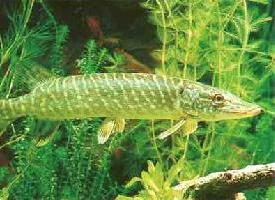
Descrierea animalului
The Northern pike, scientifically known as Esox lucius, is a captivating species of freshwater fish that is widely recognized for its distinctive appearance and voracious predatory habits. This remarkable fish is native to the northern hemisphere, thriving in the cool, temperate waters of North America, Europe, and Russia. The Northern pike is a member of the Esocidae family, which is renowned for producing some of the most formidable freshwater predators.Physically, the Northern pike is an impressive sight. It possesses a long, slender body that is perfectly adapted for an ambush predatory lifestyle. The body coloration is a captivating blend of olive green to brown, providing excellent camouflage among aquatic vegetation. This coloration is accentuated with lighter, bean-shaped spots that run along the flank, merging seamlessly with the murky waters of its habitat. The belly is usually a creamy white, creating a stark contrast. One of the most distinguishing features of the Northern pike is its duck-bill shaped mouth, which is bristling with sharp, needle-like teeth. These teeth are not only numerous but also highly efficient at gripping and slicing through prey.
Adult Northern pike can reach considerable lengths, with specimens commonly measuring over 40 inches (100 cm) long, and some exceptional individuals exceeding 55 inches (140 cm). Their weight can be equally impressive, often reaching upwards of 20 pounds (9 kg), with the largest recorded specimens tipping the scales at over 60 pounds (27 kg).
The Northern pike's diet is as formidable as its appearance. It is a carnivorous predator that preys on a wide variety of organisms, including fish, amphibians, small mammals, and even birds. Their method of hunting is both fascinating and efficient; they rely on ambush, using their camouflaged bodies to blend into the aquatic vegetation before launching a lightning-fast attack on unsuspecting prey.
Reproduction is another interesting aspect of the Northern pike's life cycle. Spawning typically occurs in the spring when water temperatures reach around 48 to 52 degrees Fahrenheit (9 to 11 degrees Celsius). Females lay thousands of eggs among aquatic vegetation, which are then fertilized by the males. The eggs hatch within a couple of weeks, depending on water temperature. Juvenile pike, known as "pike fry," are predatory from the outset, feeding on small invertebrates before progressing to larger prey as they grow.
The Northern pike plays a significant role in its ecosystem. As a top predator, it helps maintain the balance of aquatic communities by controlling the populations of smaller fish species. However, it can also become an invasive species when introduced into non-native waters, where it can disrupt local ecosystems by preying on native fish populations.
In terms of human interaction, the Northern pike is highly valued by anglers for its fighting prowess and is considered one of the most challenging freshwater game fish to catch. Its flesh is also prized in some cultures for its taste, although its numerous small bones make it somewhat difficult to prepare.
In conclusion, the Northern pike (Esox lucius) is a fascinating and formidable freshwater predator. Its unique physical characteristics, predatory efficiency, and significant role in aquatic ecosystems make it a subject of interest not only for anglers and conservationists but also for anyone fascinated by the rich diversity of life in freshwater habitats.
Animale similare
Fotografii noi cu animale
Top 10 animale
- Dolphin gull (Leucophaeus scoresbii)
- Diana monkey (Cercopithecus diana)
- Moustached guenon (Cercopithecus cephus)
- Greek tortoise (Testudo graeca)
- Stone loach (Barbatula barbatula)
- Galápagos tortoise (Geochelone nigra complex)
- Japanese macaque (Macaca fuscata)
- Russian tortoise (Testudo horsfieldii)
- Common flying dragon (Draco volans)
- Galápagos penguin (Spheniscus mendiculus)
